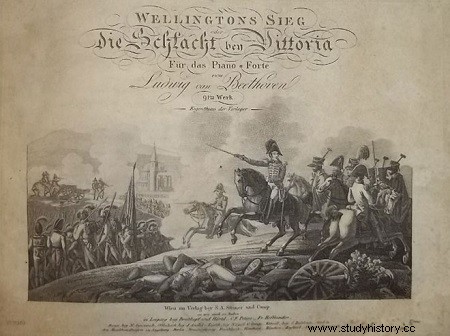
The Battle of Vitoria was fought on June 21, 1813, between French troops escorting Joseph Bonaparte in his flight and a conglomeration of British, Spanish and Portuguese troops under the command of Arthur Wellesley, future Duke of Wellington. The victory of the allies sanctioned the definitive retreat of the French troops from Spain but with the exception of Catalonia and forced Napoleon to return the crown to Ferdinand VII, thus ending the Spanish War of Independence.
Initial situation
After the decisive rout of the French at the battle of Arapiles (also known as the battle of Salamanca) (1812), the Napoleonic troops were unable to hold back the allied army in its movement towards Madrid, which was evacuated in July 1812. The following month , Wellington entered the capital. After deploying a few divisions to the area to make it safe, he marched with the main body north, where he laid siege to Burgos. However, the French resisted in the stronghold and forced him to withdraw on October 21. Later, the British left Madrid again to withdraw to Salamanca and then to Ciudad Rodrigo, where they reorganized during the winter. Meanwhile, French forces, already severely diminished and disorganized by the harsh campaign in Spain, were further reduced when several divisions were withdrawn from the Iberian Peninsula to cover other European fronts following the disastrous Russian campaign waged by Napoleon.
After the arrival of spring, Wellington again advanced northeast, reaching the Esla valley on May 20, 1813. This movement worried the French. Marshal Jean-Baptiste Jourdan withdrew the army of 58,000 men he had deployed to reoccupy the area between the Duero and Tagus rivers and concentrated it again at Burgos, prepared to ensure communications with southern France . The allied army then set out to cut off this way of retreat for Jourdan, who was already considering abandoning Spanish soil to shelter the court of Joseph I.
The battle
Wellington's army, arranged in three columns, joined the retreating French when they were near Vitoria in the Basque Country. The French were forced to fight. After a series of hard clashes, the 3rd Division under the command of Thomas Picton broke the French central front which collapsed. The French then embarked on a desperate flight towards the border of their country, leaving behind them 7,500 men dead, wounded and prisoners. They also lost 138 of their 140 guns and the abundant booty they were carrying to France. The allies (especially the British) then abandoned the pursuit of the French to divide the spoils among themselves, which angered Wellington.
Later, the Allied forces regrouped and occupied San Sebastian and Pamplona. In December, the invasion of the French Basque Country began from these bases.
Miscellaneous
When, at the end of July, the news reached Vienna, Johann Nepomuk Mælzel commissioned Ludwig van Beethoven to compose a symphony to celebrate the victory. This is The Victory of Wellington opus 91 (Wellingstons Sieg or Die Schlacht bei Vitoria or Siegessymphonie).
Currently, there is a monument in the Virgen Blanca square, in the center of Vitoria , which commemorates this event.
General information
Date June 21, 1813
Location Vitoria
Issue Decisive Allied victory, Retreat of the French army from Spain, End of the Spanish War of Independence
Belligerents French Empire United Kingdom, Kingdom of Portugal, Spain
Commanders Joseph Bonaparte, Jean-Baptiste Jourdan Arthur Wellesley
Miguel de Álava
Forces present
58,000 soldiers 140 guns
78,000 soldiers 108 guns
Losses
7,500 dead, wounded and prisoners 138 guns
5,000 dead or wounded
